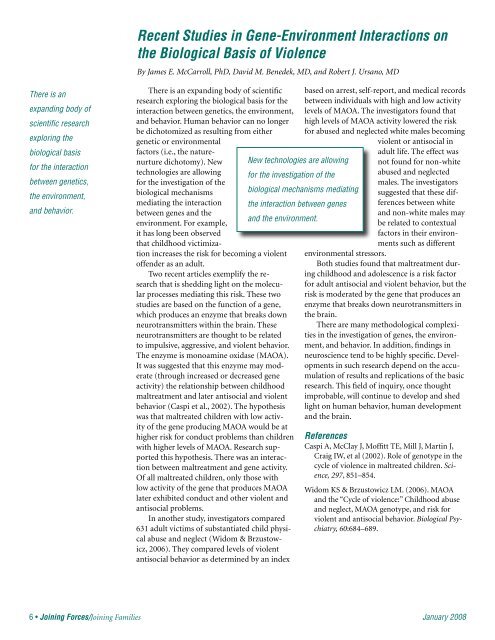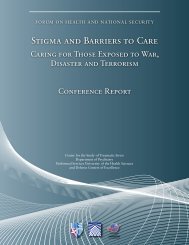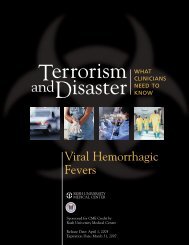An Interview With Bruce D. Perry, MD, PhD - Center for the Study of ...
An Interview With Bruce D. Perry, MD, PhD - Center for the Study of ...
An Interview With Bruce D. Perry, MD, PhD - Center for the Study of ...
Create successful ePaper yourself
Turn your PDF publications into a flip-book with our unique Google optimized e-Paper software.
Recent Studies in Gene-Environment Interactions on<br />
<strong>the</strong> Biological Basis <strong>of</strong> Violence<br />
By James E. McCarroll, <strong>PhD</strong>, David M. Benedek, <strong>MD</strong>, and Robert J. Ursano, <strong>MD</strong><br />
There is an<br />
expanding body <strong>of</strong><br />
scientific research<br />
exploring <strong>the</strong><br />
biological basis<br />
<strong>for</strong> <strong>the</strong> interaction<br />
between genetics,<br />
<strong>the</strong> environment,<br />
and behavior.<br />
There is an expanding body <strong>of</strong> scientific<br />
research exploring <strong>the</strong> biological basis <strong>for</strong> <strong>the</strong><br />
interaction between genetics, <strong>the</strong> environment,<br />
and behavior. Human behavior can no longer<br />
be dichotomized as resulting from ei<strong>the</strong>r<br />
genetic or environmental<br />
factors (i.e., <strong>the</strong> naturenurture<br />
dichotomy). New<br />
technologies are allowing<br />
<strong>for</strong> <strong>the</strong> investigation <strong>of</strong> <strong>the</strong><br />
biological mechanisms<br />
mediating <strong>the</strong> interaction<br />
between genes and <strong>the</strong><br />
environment. For example,<br />
it has long been observed<br />
that childhood victimization<br />
increases <strong>the</strong> risk <strong>for</strong> becoming a violent<br />
<strong>of</strong>fender as an adult.<br />
Two recent articles exemplify <strong>the</strong> research<br />
that is shedding light on <strong>the</strong> molecular<br />
processes mediating this risk. These two<br />
studies are based on <strong>the</strong> function <strong>of</strong> a gene,<br />
which produces an enzyme that breaks down<br />
neurotransmitters within <strong>the</strong> brain. These<br />
neurotransmitters are thought to be related<br />
to impulsive, aggressive, and violent behavior.<br />
The enzyme is monoamine oxidase (MAOA).<br />
It was suggested that this enzyme may moderate<br />
(through increased or decreased gene<br />
activity) <strong>the</strong> relationship between childhood<br />
maltreatment and later antisocial and violent<br />
behavior (Caspi et al., 2002). The hypo<strong>the</strong>sis<br />
was that maltreated children with low activity<br />
<strong>of</strong> <strong>the</strong> gene producing MAOA would be at<br />
higher risk <strong>for</strong> conduct problems than children<br />
with higher levels <strong>of</strong> MAOA. Research supported<br />
this hypo<strong>the</strong>sis. There was an interaction<br />
between maltreatment and gene activity.<br />
Of all maltreated children, only those with<br />
low activity <strong>of</strong> <strong>the</strong> gene that produces MAOA<br />
later exhibited conduct and o<strong>the</strong>r violent and<br />
antisocial problems.<br />
In ano<strong>the</strong>r study, investigators compared<br />
631 adult victims <strong>of</strong> substantiated child physical<br />
abuse and neglect (Widom & Brzustowicz,<br />
2006). They compared levels <strong>of</strong> violent<br />
antisocial behavior as determined by an index<br />
based on arrest, self-report, and medical records<br />
between individuals with high and low activity<br />
levels <strong>of</strong> MAOA. The investigators found that<br />
high levels <strong>of</strong> MAOA activity lowered <strong>the</strong> risk<br />
<strong>for</strong> abused and neglected white males becoming<br />
violent or antisocial in<br />
adult life. The effect was<br />
not found <strong>for</strong> non-white<br />
abused and neglected<br />
males. The investigators<br />
suggested that <strong>the</strong>se differences<br />
between white<br />
and non-white males may<br />
be related to contextual<br />
factors in <strong>the</strong>ir environments<br />
such as different<br />
environmental stressors.<br />
Both studies found that maltreatment during<br />
childhood and adolescence is a risk factor<br />
<strong>for</strong> adult antisocial and violent behavior, but <strong>the</strong><br />
risk is moderated by <strong>the</strong> gene that produces an<br />
enzyme that breaks down neurotransmitters in<br />
<strong>the</strong> brain.<br />
There are many methodological complexities<br />
in <strong>the</strong> investigation <strong>of</strong> genes, <strong>the</strong> environment,<br />
and behavior. In addition, findings in<br />
neuroscience tend to be highly specific. Developments<br />
in such research depend on <strong>the</strong> accumulation<br />
<strong>of</strong> results and replications <strong>of</strong> <strong>the</strong> basic<br />
research. This field <strong>of</strong> inquiry, once thought<br />
improbable, will continue to develop and shed<br />
light on human behavior, human development<br />
and <strong>the</strong> brain.<br />
New technologies are allowing<br />
<strong>for</strong> <strong>the</strong> investigation <strong>of</strong> <strong>the</strong><br />
biological mechanisms mediating<br />
<strong>the</strong> interaction between genes<br />
and <strong>the</strong> environment.<br />
References<br />
Caspi A, McClay J, M<strong>of</strong>fitt TE, Mill J, Martin J,<br />
Craig IW, et al (2002). Role <strong>of</strong> genotype in <strong>the</strong><br />
cycle <strong>of</strong> violence in maltreated children. Science,<br />
297, 851–854.<br />
Widom KS & Brzustowicz LM. (2006). MAOA<br />
and <strong>the</strong> “Cycle <strong>of</strong> violence:” Childhood abuse<br />
and neglect, MAOA genotype, and risk <strong>for</strong><br />
violent and antisocial behavior. Biological Psychiatry,<br />
60:684–689.<br />
6 • Joining Forces/Joining Families January 2008




